
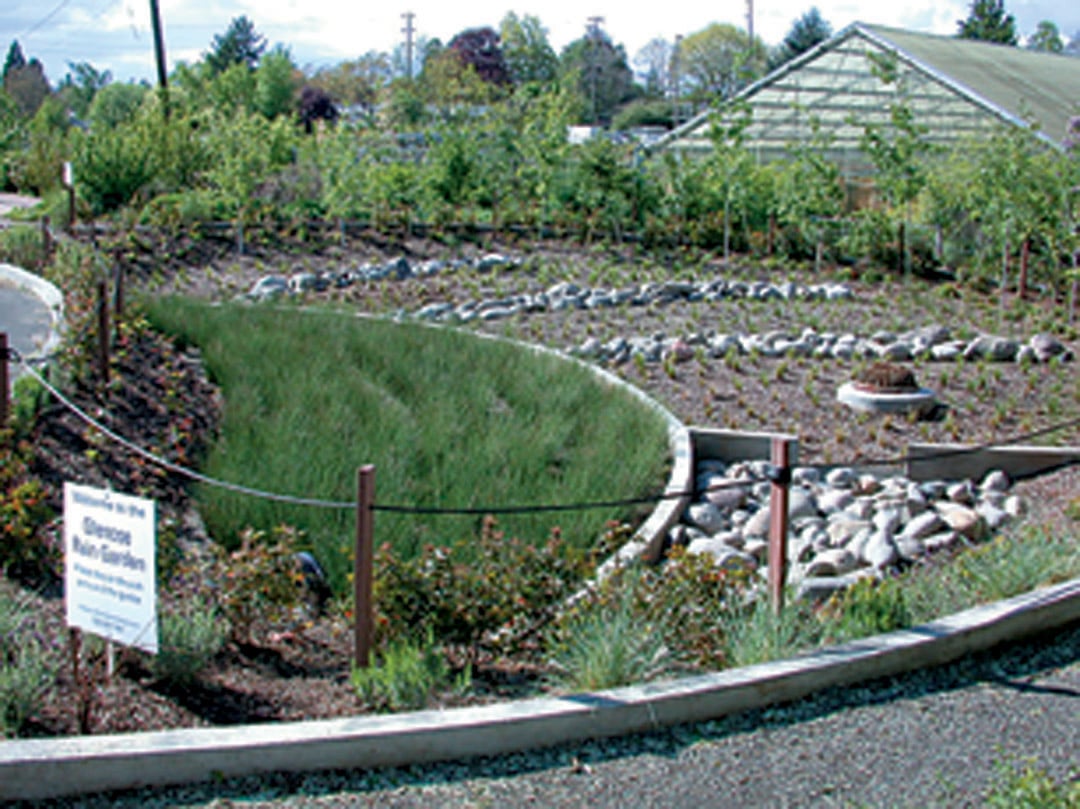
Contributor
- Topics: Archive
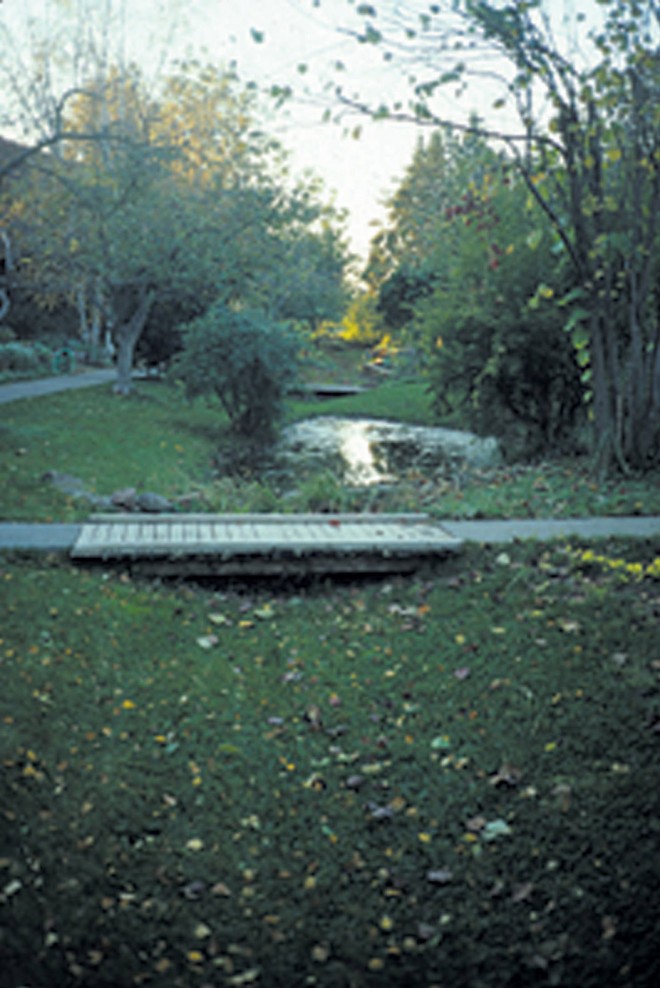
“Turning stormwater challenges into benefits” is the heart of Brock Dolman’s message, his gospel for a Gaian future and an ecoliterate culture for human beings. Brock Dolman directs the Watershed Advocacy Training Education and Research Institute, (WATER) at the Occidental Arts and Ecology Center (OAEC), a Northern California site of extensive organic gardens and its own brand of permaculture educational programs since the early 1970s, when it was known as the Farallones Institute. As recent witnesses to the unbearable scale of destruction of both life and property along the lower Mississippi River, and in light of the unpredictable effects of global warming, we have become aware of the importance of understanding how water flows in nature and of becoming more water-literate and collectively capable of preventing stormwater damage before it occurs.
I enrolled in a workshop entitled “Erosion Control and Water Management” at OAEC because Brock’s talk and slide presentation at the Bioneers 2004 conference inspired me deeply and moved me to action. As a garden designer and horticulturist working in residential settings, I saw this as the next step in my professional training—understanding storm-water flow on a property, or in a neighborhood, independent of the municipal water supply, and independent of the typical engineered solution. (I received my garden education when water came through rubber hoses, overhead sprinklers, and watering cans.) I wanted to understand what gardening in our winter-wet, summer-dry climate would be like without municipal water in summer, particularly knowing that the water agencies would love us to use less of it. I needed to know my responsibilities, as a designer, toward water and watershed health.
At the conference, Brock’s slides flashed the vocabulary of water literacy before me: the flow of water on slopes, the function of a stream meander and its “sinuosity,” the topography of a watershed (from the sky’s point of view). These natural systems comprised the human experience of water before industrially driven engineering introduced pipes, culverts, and dams. The images were riveting, the language rich, replete with sexy slogans and easily called up mnemonics, delivered in a dynamic, engaging, conversational style. This, in itself, felt like a watershed event in public education. We were talking together about water, land, plants people, and wildlife in ways our ancestors may have understood. Brock was bringing the pre-industrial landscape of water back to life.
From the classroom presentation at OAEC, we walked outdoors to an unremarkable patch of gravelly clay parking lot, a sort of unpaved dirt road. Brock challenged us with questions: Where would Storm-water come from? Where would it go unchecked? Where should it go to prevent erosion and recharge groundwater? Brock introduced the concept of “low impact, practical, small-scale, surface- water management techniques for roads, parking lots, and homes.” By envisioning a series of small ridges (berms) and declivities (swales) placed at cross angles to the oncoming rush of water, we could see how stormwater could be diverted and directed off-road to recharge the subsoil and make it available to the vegetable garden and fruit trees below. The frequency of interception was critical for the success of this erosion prevention strategy.
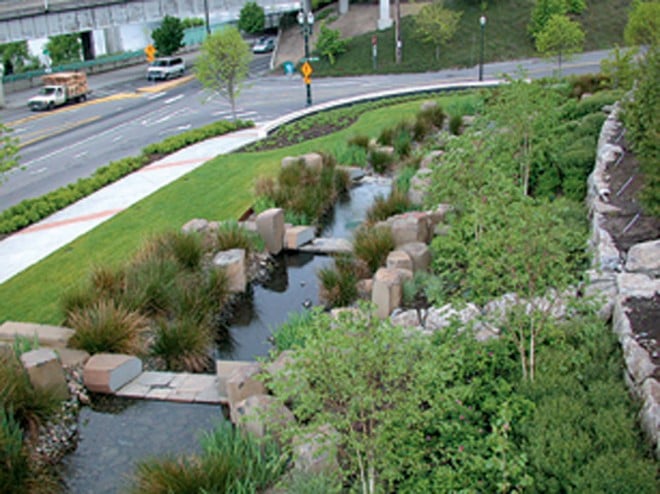
Slow It, Spread It, Sink It
The new “Slow Water Movement” mantra advises us to minimize topsoil loss and avoid siltation of the watershed, while optimizing the retention of water on site by encouraging it to sink in where it lands. To illustrate this, Brock led us along another dirt road to view a steep slope of dismal, second-growth woodland, seriously eroded with gullies channeling down it in deep cuts. As a result of long-term fire suppression, Douglas firs (Pseudotsuga menziesii) had begun to overtake the coast live oak (Quercus agrifolia), madrones (Arbutus menziesii), and bay laurels (Umbellularia californica). Here, Brock implemented a seven-point “Conservation Hydrology” program to encourage a healthier woodland:
- Restore hardwood and mixed evergreen forest
- Reduce fuel load and enhance fire resiliency
- Promote soil retention
- Recharge groundwater and improve surface water quality
- Recover biological and botanical diversity
- Create site accessibility
- Manifest beauty
On this particular site, they began by selectively limbing or felling the Douglas firs. The cut saplings and branches are gathered (reducing fuel load) and stuffed tightly into the raw gullies at intervals in their fall so as to trap the water and sediment running off the dirt road. At each layered branch-and sapling trap, the slowed water sinks into the soil, recharging the slope’s groundwater; water becomes available again to plants and wildlife on the slope. No sediment reaches the coho salmon-bearing stream below to silt up the aquatic creatures’ living space or travel routes. The fuel for a future destructive fire is transformed into earth and water, by design—and by human hands.
As I observed these practices being put in place, I felt a deep sense of relief, feeling that somebody knew what to do to heal this wounded place. I could see the basis for the return, not only of the forest, but also its lovely understory—its graceful evergreen shrubs, groundcovers, bulbs, and ferns. An ugly eroded slope would be revitalized through the repetition of these simple water-management techniques.
On a much larger scale, California’s Department of Fish and Game will spend $500,000 in Dutch Bill Watershed, a tributary to the Russian River, for storm-proofing its private roads to prevent siltation, for the sake of endangered salmonids. Those guiding the project recognize that erosion prevention is less costly than dealing with unchecked siltation downstream.
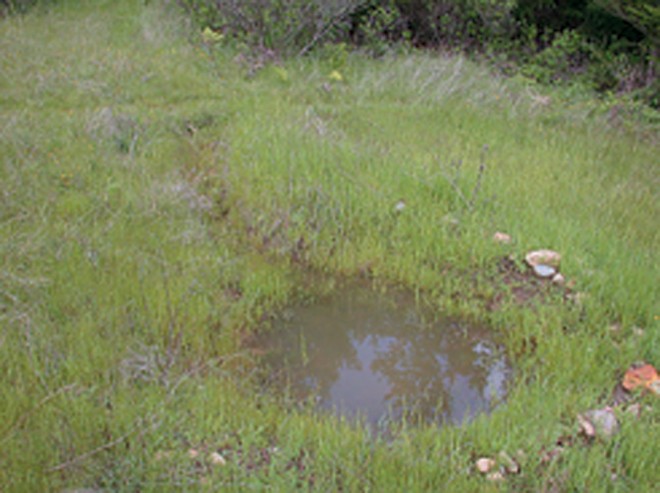
Retain It, Don’t Drain It
Moving farther up the slope toward the crest of this inner coastal ridge, the woodland opened onto a sunny hillside meadow—a delightfully elegant sweep alive with nodding heads of purple needlegrass (Nassella pulchra), California oatgrass (Danthonia californica), blue wild rye (Elymus glaucus), and wildflowers—crowned on top by a wide pond of clear water quietly reflecting the blue sky. The meadow had been wrested from a patch of invasive Scotch and French broom by severing the top growth of each broom at the soil line during the height of the dry season and then torching any new sprouts that appeared the following spring. This technique reduces soil disturbance and subsequent seed germination (weed seeds germinate best in open disturbed soils).
The large pond (six acre-feet) catches rainfall and provides all the irrigation for more than three acres of certified organic vegetable and fruit gardens below; its waters are tangibly healthy and clean, with no visible sign of imbalance. Without this pond, there would be no gardens on the current scale, and no food for the center’s residents. Catching, storing and slowly releasing winter rainwater provides the only source of summer water for this Western Sonoma County farm. Built in 1978 for $10,000, the pond has proven the wisdom of the investment.
Basins of Relations
With the hardwood forest restoration under way, the native grass and wildflower meadow complete, and the pond catching and holding rainwater for the garden, we see the manifold fruits of watershed restoration. The key is its water held close to the land in the soils of its slopes.
Brock emphasized that up to ninety percent of the water in a watershed is in its terrestrial basin, held like a sponge in the slopes, soils, perched aquifers, and vegetation of the uplands. In the OAEC example, the water has been seized at the headwaters (the catchment pond on the ridgetop), by the lush meadow grasses and wildflowers in the open uplands, and in the long slope of soil and water restoration, supported by the mixed evergreen forest that extends to the stream below. The value of this restoration—economically, visually, ecologically, and in human terms—is priceless. The cost is the labor invested by the landholders, Sowing Circle LLC, an intentional community, who have been able to accomplish this resurrection on degraded, logged-out slopes in careful, measured steps over the past ten years.
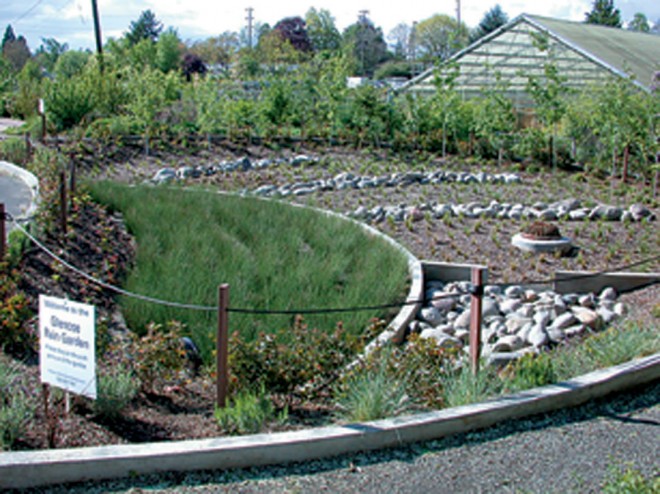
Raingardens
Elsewhere similar efforts are taking place, both individually and collectively, to bring watershed restoration benefits to local communities. Throughout the Northwest and in parts of California, raingardens are appearing in designed landscapes at all scales of development. In Seattle’s “Street Edge Alternatives,” winter rains are captured in gently graded bioswales that have been planted with flowering perennials along the street’s margin; the straight street has been given a sinuous curve to slow down traffic. In Portland, Ole Ersson captures rainwater from his roof, and keeps his family of four in drinking water year-round. In the Glencoe Raingarden in Portland, petroleum-polluted parking lot water is biofiltered with sedges and allowed to recharge the groundwater. At Cabrillo College in Aptos, California, the landscape around the buildings and parking lots of the new Horticulture Department includes a retention pond to collect storm-water; there, it is biofiltered with wetland plants, recharging the groundwater, making a habitat for frogs and song sparrows, and enhancing the beauty of the complex.
Among the earliest examples of watershed restoration is the Village Homes subdivision in Davis, California, where substantial corridors between rows of houses were developed as a series of long green bioswales featuring informal sweeps of native and other plants that benefit from the collected water; the water table has risen fifteen feet since the project’s inception in the early 1970s. At the Jean Vollum Natural Capital Center Ecotrust Building in Portland, a green living roof has been planted atop the building, and the parking lot is designed to intercept and biofilter all polluted stormwater.
In all of these examples, stormwater catchment and interception strategies have resulted in attractive contributions to local landscapes, local watersheds, and local communities with exponentially accruing long-term benefits, as long as they are properly maintained and monitored.
Don’t Use It, Don’t Need It
The best way to conserve water is to find ways to use less of it in the landscape. In a watershed supporting a built environment, every property owner can help maintain the health of the watershed by intercepting runoff and recharging groundwater. In a residential neighborhood, converting even one front lawn composed of grasses from summer-wet climates into one adapted to summer drought will have a positive effect on the whole watershed; leaving them un-mowed to flower and fruit will feed insects and wildlife. On farms and ranches, water catchment in ponds and cisterns are attractive alternatives to municipal water.
Brock teaches that “water drives design” and that the challenge of creating ponds that do not attract mosquitoes is a design one. Mosquitoes cannot lay eggs on water in which the surface tension is broken, by a fountain for instance. One solution in a large pond is recirculating the water through “flowforms” to an adjunct smaller biofiltration pond. An asset of this arrangement is that, by favoring the newt, frog, dragonfly, and other beneficial insect populations, their helpful predation will tend to keep your plant material healthy and your garden free of mosquitoes.
Other strategies for the built environment include pervious concrete and grass-pavers (for use in driveways), and green rooftops planted to grasses and other plants with substantial insulating effects in all seasons.
As I left class to stroll through the OAEC gardens alone, I was touched by the presence of some flowers favored by my first horticulture teacher, Alan Chadwick, whose disciple pioneered the north garden at the center. There were his pink and red Shirley poppies (Papaver rhoeas), cobalt spires of anchusa (Anchusa azurea) and warm rainbow tints of Russell lupines (Lupinus Russell hybrids). I gave him thanks for what I sometimes refer to as the first “real” things I learned in life, among them the craft of spading and forking a double-dug raised bed, which, because of its mounded shape, lifelike texture, and aeration, could hold water in the soil like a sponge. For some reason, he always told us to make our gardens on slopes. I now think it was because of the dynamic equilibrium that exists between the soils and the water they hold on the slopes.
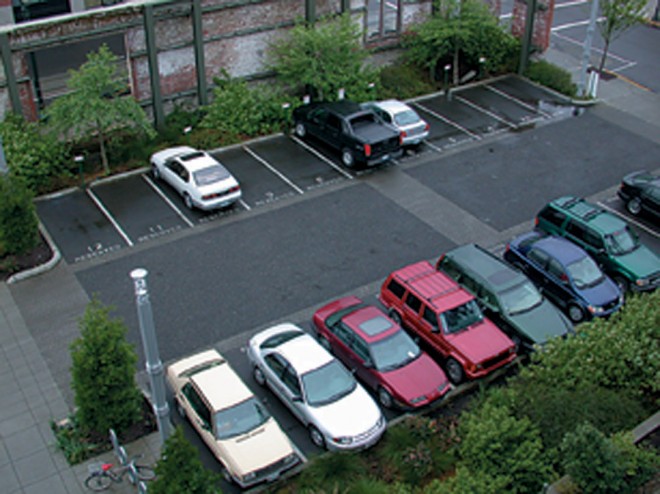
For Further Reading
To understand how best to address the biggest source of sedimentation on the California coast and in the Northwest, namely runoff from dirt roads— logging, ranch, rural, residential—consult the Handbook for Forest and Ranch Roads by Danny Hagans and Bill Weaver, available from the Mendocino Resource Conservation District along with a companion video.
In Water for Every Farm, Yeomans’ Keyline Plan, PA Yeomans describes the keyline concept and use of the A-frame strategy for locating contour levels for bioswales, so that water can be collected and managed with optimum elegance and efficiency.
For the full story of the Village Homes pro-ject in Davis, California, read Natural Drainage—Corbett and Corbett: Designing Sustainable Communities, Learning from Village Homes.
Share:
Social Media
Garden Futurist Podcast
Most Popular
Videos
Topics
Related Posts

Ground Up Science for Greener Cities with Garden Futurist Dr. Alessandro Ossola
Spring 2023 Listen to the Podcast here. Alessandro Ossola is a scientist who gets very excited about the challenge of climate change allowing for an

Readying Urban Forests for Climate Realities with Garden Futurist Dr. Greg McPherson
Winter 2023 Listen to the Podcast here. “Going from the mow and blow to a more horticulturally knowledgeable approach to maintaining the landscape. And that

Low Maintenance Gardens – Better for Pollinators and People
Autumn 2022 “I come out every day. It’s therapy, my meditation.” Janet’s young garden transformed from overgrown, invasive plants to mostly natives. The dailiness of

Invasive Plants Are Still Being Sold: Preventing Noxious Weeds in Your Landscape
Autumn 2022 With so many beautiful ornamental plant species and cultivars throughout California and the Pacific Northwest, how do you decide which ones to include









Responses